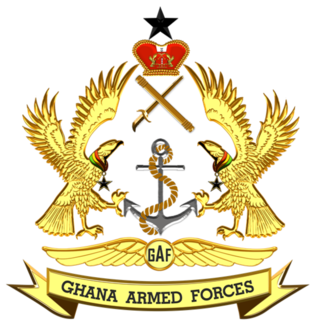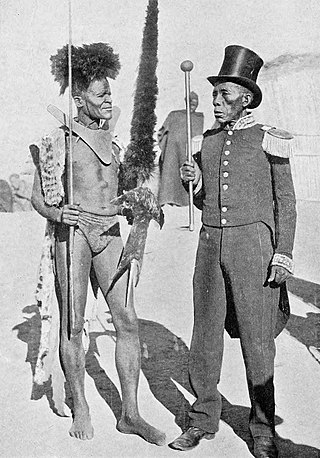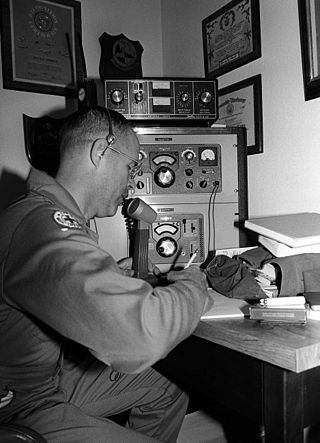
The Ghana Armed Forces (GAF) is the unified armed force of Ghana, consisting of the Army (GA), Navy (GN), and Ghana Air Force.

Lesotho, formally the Kingdom of Lesotho, is a landlocked country in Southern Africa. As an enclave of South Africa, with which it shares a 1,106 km border, it is the only sovereign enclave in the world outside of the Italian Peninsula. It is situated in the Maloti Mountains and contains the highest peak in Southern Africa. It has an area of over 30,000 km2 (11,600 sq mi) and has a population of about 2 million. Its capital and largest city is Maseru.

The history of people living in the area now known as Lesotho goes back as many as 400 years. Present Lesotho emerged as a single polity under King Moshoeshoe I in 1822. Under Moshoeshoe I, Basotho joined other clans in their struggle against the Lifaqane associated with famine and the reign of Shaka Zulu from 1818 to 1828.

A military, also known collectively as an armed forces, are a heavily armed, highly organized force primarily intended for warfare. Militaries are typically authorized and maintained by a sovereign state, with their members identifiable by a distinct military uniform. They may consist of one or more military branches such as an army, navy, air force, space force, marines, or coast guard. The main task of a military is usually defined as defence of their state and its interests against external armed threats.
Second lieutenant is a junior commissioned officer military rank in many armed forces. The lowest officer rank, it is usually placed below lieutenant or first lieutenant.

Schutztruppe was the official name of the colonial troops in the African territories of the German colonial empire from the late 19th century to 1918. Similar to other colonial armies, the Schutztruppen consisted of volunteer European commissioned and non-commissioned officers, medical and veterinary officers. Most enlisted ranks were recruited from indigenous communities within the German colonies or from elsewhere in Africa.

The Army Reserve (AR) is the reserve land component of the Irish Defence Forces. It is the second line reserve of the Irish Army. The Army Reserve involves active military service on a part-time basis, and is one of two elements of the Reserve Defence Forces, the other element being the Naval Service Reserve (NSR).

Joseph Leabua Jonathan was the first prime minister of Lesotho. He succeeded Chief Sekhonyana Nehemia Maseribane following a by-election and held that post from 1965 to 1986.

Military service is service by an individual or group in an army or other militia, air forces, and naval forces, whether as a chosen job (volunteer) or as a result of an involuntary draft (conscription).

The Basuto Gun War, also known as the Basutoland Rebellion, was a conflict between the Basuto and the British Cape Colony. It lasted from 13 September 1880 to 29 April 1881 and ended in a Basuto victory.

Auxiliaries are support personnel that assist the military or police but are organised differently from regular forces. Auxiliary may be military volunteers undertaking support functions or performing certain duties such as garrison troops, usually on a part-time basis. Unlike a military reserve force, an auxiliary force does not necessarily have the same degree of training or ranking structure as regular soldiers, and it may or may not be integrated into a fighting force. Some auxiliaries, however, are militias composed of former active duty military personnel and actually have better training and combat experience than their regular counterparts.
General Justin Metsing Lekhanya was the Minister of Defence and Chairman of the Military Council of Lesotho from 24 January 1986 to 2 May 1991.

The British South Africa Police (BSAP) was, for most of its existence, the police force of Southern Rhodesia and Rhodesia. It was formed as a paramilitary force of mounted infantrymen in 1889 by Cecil Rhodes' British South Africa Company, from which it took its original name, the British South Africa Company's Police. Initially run directly by the company, it began to operate independently in 1896, at which time it also dropped "Company's" from its name. It thereafter served as Rhodesia's regular police force, retaining its name, until 1980, when it was superseded by the Zimbabwe Republic Police, soon after the country's reconstitution into Zimbabwe in April that year.

The Lesotho Defence Force (LDF) is the military of the Southern African Kingdom of Lesotho, which consists of about 2,000 personnel and is tasked with maintaining internal security, territorial integrity, and defending the constitution of Lesotho. Since the mountainous kingdom is completely landlocked by South Africa, in practice the country's external defence is guaranteed by its larger neighbour, so the armed forces are mainly used for internal security. The LDF is an army with a small air wing.

The Botswana Defence Force is the military of Botswana. The main component of the BDF is the Botswana Ground Force; there is also an air wing and a riverine patrol contingent attached to the ground forces, with 10 Panther airboats and 2 Boston Whaler Raider class.
Major-General Elias Phisoana Ramaema was Chairman of the Military Council and Council of Ministers of Lesotho from 2 May 1991 to 2 April 1993.

Military personnel or military service members are members of the state's armed forces. Their roles, pay, and obligations differ according to their military branch, rank, and their military task when deployed on operations and on exercise.

Sri Lanka Police is the civilian national police force of the Democratic Socialist Republic of Sri Lanka. The police force is responsible for enforcing criminal and traffic law, enhancing public safety, maintaining order and keeping the peace throughout Sri Lanka. The police force consists of 43 Territorial Divisions, 67 Functional Divisions, 432 Police Stations with more than 84,000 people. The professional head of the police is the Inspector General of Police who reports to the Minister of Law and Order as well as the National Police Commission. The current Inspector General of Police (Acting) is Deshabandu Tennakoon.

The Botswana Police Service is the police service of Botswana and it is a part of Ministry of Defence, Justice and Security. The force has 9,500 police officers.

The African Auxiliary Pioneer Corps (AAPC) was a unit of the British Colonial Auxiliary Forces recruited among Africans from the High Commission Territories (HCT). It was established in July 1941, after the paramount chiefs of the HCT managed to convince the colonial authorities to create an independent force consisting of their subjects. During its service it provided crucial logistical support to the Allied war effort during the North African, Dodecanese and Italian campaigns. Initially a labor unit, AAPC's duties were gradually expanded to include anti-aircraft artillery operation and other combat duties. It was commanded by Colonel H. G. L. Prynne and numbered 36,000 men, 1,216 of whom died in the war. The last AAPC soldiers were repatriated in spring 1946 and the unit was disbanded in 1949.













































